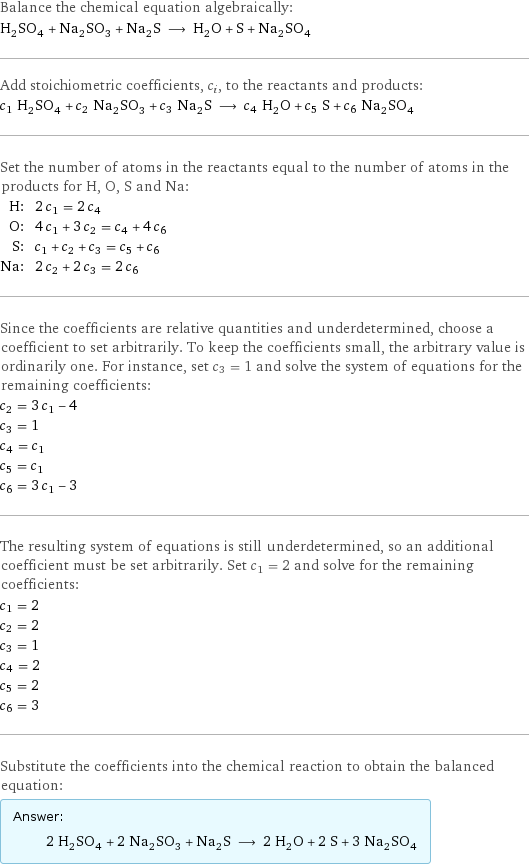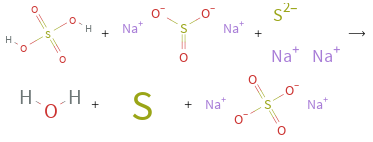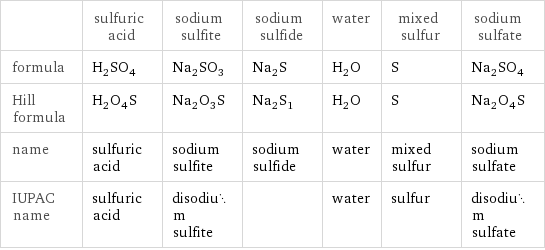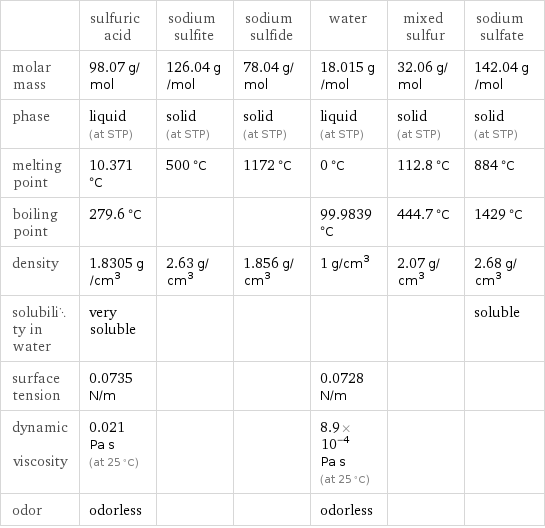Input interpretation

H_2SO_4 sulfuric acid + Na_2SO_3 sodium sulfite + Na_2S sodium sulfide ⟶ H_2O water + S mixed sulfur + Na_2SO_4 sodium sulfate
Balanced equation

Balance the chemical equation algebraically: H_2SO_4 + Na_2SO_3 + Na_2S ⟶ H_2O + S + Na_2SO_4 Add stoichiometric coefficients, c_i, to the reactants and products: c_1 H_2SO_4 + c_2 Na_2SO_3 + c_3 Na_2S ⟶ c_4 H_2O + c_5 S + c_6 Na_2SO_4 Set the number of atoms in the reactants equal to the number of atoms in the products for H, O, S and Na: H: | 2 c_1 = 2 c_4 O: | 4 c_1 + 3 c_2 = c_4 + 4 c_6 S: | c_1 + c_2 + c_3 = c_5 + c_6 Na: | 2 c_2 + 2 c_3 = 2 c_6 Since the coefficients are relative quantities and underdetermined, choose a coefficient to set arbitrarily. To keep the coefficients small, the arbitrary value is ordinarily one. For instance, set c_3 = 1 and solve the system of equations for the remaining coefficients: c_2 = 3 c_1 - 4 c_3 = 1 c_4 = c_1 c_5 = c_1 c_6 = 3 c_1 - 3 The resulting system of equations is still underdetermined, so an additional coefficient must be set arbitrarily. Set c_1 = 2 and solve for the remaining coefficients: c_1 = 2 c_2 = 2 c_3 = 1 c_4 = 2 c_5 = 2 c_6 = 3 Substitute the coefficients into the chemical reaction to obtain the balanced equation: Answer: | | 2 H_2SO_4 + 2 Na_2SO_3 + Na_2S ⟶ 2 H_2O + 2 S + 3 Na_2SO_4
Structures

+ + ⟶ + +
Names

sulfuric acid + sodium sulfite + sodium sulfide ⟶ water + mixed sulfur + sodium sulfate
Equilibrium constant
![Construct the equilibrium constant, K, expression for: H_2SO_4 + Na_2SO_3 + Na_2S ⟶ H_2O + S + Na_2SO_4 Plan: • Balance the chemical equation. • Determine the stoichiometric numbers. • Assemble the activity expression for each chemical species. • Use the activity expressions to build the equilibrium constant expression. Write the balanced chemical equation: 2 H_2SO_4 + 2 Na_2SO_3 + Na_2S ⟶ 2 H_2O + 2 S + 3 Na_2SO_4 Assign stoichiometric numbers, ν_i, using the stoichiometric coefficients, c_i, from the balanced chemical equation in the following manner: ν_i = -c_i for reactants and ν_i = c_i for products: chemical species | c_i | ν_i H_2SO_4 | 2 | -2 Na_2SO_3 | 2 | -2 Na_2S | 1 | -1 H_2O | 2 | 2 S | 2 | 2 Na_2SO_4 | 3 | 3 Assemble the activity expressions accounting for the state of matter and ν_i: chemical species | c_i | ν_i | activity expression H_2SO_4 | 2 | -2 | ([H2SO4])^(-2) Na_2SO_3 | 2 | -2 | ([Na2SO3])^(-2) Na_2S | 1 | -1 | ([Na2S])^(-1) H_2O | 2 | 2 | ([H2O])^2 S | 2 | 2 | ([S])^2 Na_2SO_4 | 3 | 3 | ([Na2SO4])^3 The equilibrium constant symbol in the concentration basis is: K_c Mulitply the activity expressions to arrive at the K_c expression: Answer: | | K_c = ([H2SO4])^(-2) ([Na2SO3])^(-2) ([Na2S])^(-1) ([H2O])^2 ([S])^2 ([Na2SO4])^3 = (([H2O])^2 ([S])^2 ([Na2SO4])^3)/(([H2SO4])^2 ([Na2SO3])^2 [Na2S])](../image_source/6a912e345478e8ff000c14ef00d4eea4.png)
Construct the equilibrium constant, K, expression for: H_2SO_4 + Na_2SO_3 + Na_2S ⟶ H_2O + S + Na_2SO_4 Plan: • Balance the chemical equation. • Determine the stoichiometric numbers. • Assemble the activity expression for each chemical species. • Use the activity expressions to build the equilibrium constant expression. Write the balanced chemical equation: 2 H_2SO_4 + 2 Na_2SO_3 + Na_2S ⟶ 2 H_2O + 2 S + 3 Na_2SO_4 Assign stoichiometric numbers, ν_i, using the stoichiometric coefficients, c_i, from the balanced chemical equation in the following manner: ν_i = -c_i for reactants and ν_i = c_i for products: chemical species | c_i | ν_i H_2SO_4 | 2 | -2 Na_2SO_3 | 2 | -2 Na_2S | 1 | -1 H_2O | 2 | 2 S | 2 | 2 Na_2SO_4 | 3 | 3 Assemble the activity expressions accounting for the state of matter and ν_i: chemical species | c_i | ν_i | activity expression H_2SO_4 | 2 | -2 | ([H2SO4])^(-2) Na_2SO_3 | 2 | -2 | ([Na2SO3])^(-2) Na_2S | 1 | -1 | ([Na2S])^(-1) H_2O | 2 | 2 | ([H2O])^2 S | 2 | 2 | ([S])^2 Na_2SO_4 | 3 | 3 | ([Na2SO4])^3 The equilibrium constant symbol in the concentration basis is: K_c Mulitply the activity expressions to arrive at the K_c expression: Answer: | | K_c = ([H2SO4])^(-2) ([Na2SO3])^(-2) ([Na2S])^(-1) ([H2O])^2 ([S])^2 ([Na2SO4])^3 = (([H2O])^2 ([S])^2 ([Na2SO4])^3)/(([H2SO4])^2 ([Na2SO3])^2 [Na2S])
Rate of reaction
![Construct the rate of reaction expression for: H_2SO_4 + Na_2SO_3 + Na_2S ⟶ H_2O + S + Na_2SO_4 Plan: • Balance the chemical equation. • Determine the stoichiometric numbers. • Assemble the rate term for each chemical species. • Write the rate of reaction expression. Write the balanced chemical equation: 2 H_2SO_4 + 2 Na_2SO_3 + Na_2S ⟶ 2 H_2O + 2 S + 3 Na_2SO_4 Assign stoichiometric numbers, ν_i, using the stoichiometric coefficients, c_i, from the balanced chemical equation in the following manner: ν_i = -c_i for reactants and ν_i = c_i for products: chemical species | c_i | ν_i H_2SO_4 | 2 | -2 Na_2SO_3 | 2 | -2 Na_2S | 1 | -1 H_2O | 2 | 2 S | 2 | 2 Na_2SO_4 | 3 | 3 The rate term for each chemical species, B_i, is 1/ν_i(Δ[B_i])/(Δt) where [B_i] is the amount concentration and t is time: chemical species | c_i | ν_i | rate term H_2SO_4 | 2 | -2 | -1/2 (Δ[H2SO4])/(Δt) Na_2SO_3 | 2 | -2 | -1/2 (Δ[Na2SO3])/(Δt) Na_2S | 1 | -1 | -(Δ[Na2S])/(Δt) H_2O | 2 | 2 | 1/2 (Δ[H2O])/(Δt) S | 2 | 2 | 1/2 (Δ[S])/(Δt) Na_2SO_4 | 3 | 3 | 1/3 (Δ[Na2SO4])/(Δt) (for infinitesimal rate of change, replace Δ with d) Set the rate terms equal to each other to arrive at the rate expression: Answer: | | rate = -1/2 (Δ[H2SO4])/(Δt) = -1/2 (Δ[Na2SO3])/(Δt) = -(Δ[Na2S])/(Δt) = 1/2 (Δ[H2O])/(Δt) = 1/2 (Δ[S])/(Δt) = 1/3 (Δ[Na2SO4])/(Δt) (assuming constant volume and no accumulation of intermediates or side products)](../image_source/d7d95b9f07266115fddadf5bb0f45282.png)
Construct the rate of reaction expression for: H_2SO_4 + Na_2SO_3 + Na_2S ⟶ H_2O + S + Na_2SO_4 Plan: • Balance the chemical equation. • Determine the stoichiometric numbers. • Assemble the rate term for each chemical species. • Write the rate of reaction expression. Write the balanced chemical equation: 2 H_2SO_4 + 2 Na_2SO_3 + Na_2S ⟶ 2 H_2O + 2 S + 3 Na_2SO_4 Assign stoichiometric numbers, ν_i, using the stoichiometric coefficients, c_i, from the balanced chemical equation in the following manner: ν_i = -c_i for reactants and ν_i = c_i for products: chemical species | c_i | ν_i H_2SO_4 | 2 | -2 Na_2SO_3 | 2 | -2 Na_2S | 1 | -1 H_2O | 2 | 2 S | 2 | 2 Na_2SO_4 | 3 | 3 The rate term for each chemical species, B_i, is 1/ν_i(Δ[B_i])/(Δt) where [B_i] is the amount concentration and t is time: chemical species | c_i | ν_i | rate term H_2SO_4 | 2 | -2 | -1/2 (Δ[H2SO4])/(Δt) Na_2SO_3 | 2 | -2 | -1/2 (Δ[Na2SO3])/(Δt) Na_2S | 1 | -1 | -(Δ[Na2S])/(Δt) H_2O | 2 | 2 | 1/2 (Δ[H2O])/(Δt) S | 2 | 2 | 1/2 (Δ[S])/(Δt) Na_2SO_4 | 3 | 3 | 1/3 (Δ[Na2SO4])/(Δt) (for infinitesimal rate of change, replace Δ with d) Set the rate terms equal to each other to arrive at the rate expression: Answer: | | rate = -1/2 (Δ[H2SO4])/(Δt) = -1/2 (Δ[Na2SO3])/(Δt) = -(Δ[Na2S])/(Δt) = 1/2 (Δ[H2O])/(Δt) = 1/2 (Δ[S])/(Δt) = 1/3 (Δ[Na2SO4])/(Δt) (assuming constant volume and no accumulation of intermediates or side products)
Chemical names and formulas

| sulfuric acid | sodium sulfite | sodium sulfide | water | mixed sulfur | sodium sulfate formula | H_2SO_4 | Na_2SO_3 | Na_2S | H_2O | S | Na_2SO_4 Hill formula | H_2O_4S | Na_2O_3S | Na_2S_1 | H_2O | S | Na_2O_4S name | sulfuric acid | sodium sulfite | sodium sulfide | water | mixed sulfur | sodium sulfate IUPAC name | sulfuric acid | disodium sulfite | | water | sulfur | disodium sulfate
Substance properties

| sulfuric acid | sodium sulfite | sodium sulfide | water | mixed sulfur | sodium sulfate molar mass | 98.07 g/mol | 126.04 g/mol | 78.04 g/mol | 18.015 g/mol | 32.06 g/mol | 142.04 g/mol phase | liquid (at STP) | solid (at STP) | solid (at STP) | liquid (at STP) | solid (at STP) | solid (at STP) melting point | 10.371 °C | 500 °C | 1172 °C | 0 °C | 112.8 °C | 884 °C boiling point | 279.6 °C | | | 99.9839 °C | 444.7 °C | 1429 °C density | 1.8305 g/cm^3 | 2.63 g/cm^3 | 1.856 g/cm^3 | 1 g/cm^3 | 2.07 g/cm^3 | 2.68 g/cm^3 solubility in water | very soluble | | | | | soluble surface tension | 0.0735 N/m | | | 0.0728 N/m | | dynamic viscosity | 0.021 Pa s (at 25 °C) | | | 8.9×10^-4 Pa s (at 25 °C) | | odor | odorless | | | odorless | |
Units
